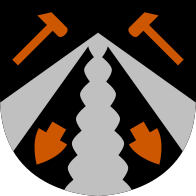Coat of arms of the Vincennes branch of the House of Fox Ridge

The coat of arms of the Vincennes branch of the house of Fox Ridge was designed in June 2021 by Miles Bradley Huff, and posthumously awarded by him to his late grandfather; who immediately passed the arms down to Miles's father. Miles will one day inherit these arms.
Symbolism
The piles "traditionally" represent engineering, bridges, building, etc. 2+ generations of my ancestors worked at a bridge factory, as did other Huffs.
The outer two piles come together to form a bridge. Really driving the above symbolism home.The hammers over the bridge "traditionally" represent the labor of craftsmen, blacksmiths, and carpenters. My great grandpa was a blacksmith for the coal mines.
The sort of hammer I chose to depict (the ball-peen hammer) was heavily used by my grandparents in the bridge factory where they worked.The area beneath the bridge, including the center pile, represents a hill. "Huff" is said to come from Old English "hoh", which means "hill".
Specifically, this hill is Fox Ridge, where our section of the Huff family began back in the 1800s.The center pile is invected, a style that "traditionally" represents land. In this case, the center pile specifically represents farmland (which Huffs worked tirelessly).
The plowshares "traditionally" represent agricultural toil. In these arms, they are located to either side of the center pile, forming furrows in the field (double entendre intended).
Each tool represents a different forebear and his primary occupation in life, stretching from the dynasty founder (Eleven Right) to the person to whom these arms were awarded (Jonathan Miles), with each being a different tool:
Eleven Right is the plowshare dexter, Miles is the plowshare sinister, Eleven Ledford is the hammer dexter, and Jonathan Miles is the hammer sinister.The background is sable (black), "traditionally" meaning "constancy" or "grief". In this case, it represents the hard realities my ancestors endured.
The foreground is argent (silver/white), "traditionally" meaning "sincerity". Argent is a metal, and of the two metals available for heraldry, it is the closest in color to the steel my ancestors forged and shaped.— Miles Huff, June 2021[1]
Original version

The original version had tawny tools, intended to bear the following symbolism:
The tools are tenné (tawny), traditionally meaning "ambition", "optimism", or "enthusiasm". Tenné is also a stain, which is one of two or three special colors not used in medieval armorie, and sometimes used to indicate illegitimacy. This second meaning is also intended, here: the founder of our dynasty was a bastard, we all lack noble blood, and our arms were self-assumed. Tawny tools, in this case, therefore represent the labor of ignoble men.
— Miles Huff, June 2021[2]
These arms were criticized for making use of tawny, which is not a common color in heraldry; and for placing it on another color (by those who consider stains to be colors, rather than a separate category).[2] Miles had intended for tawny to be leather, and to function as a fur. After briefly considering copper, he and his family decided to go for monochrome argent/sable.
In micronationalism
These arms appear in Swena's achievement for the Vishwamitran Order of the Lotus and the Indradhanushian Order of Chandrachur I.